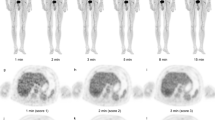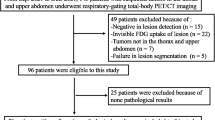Abstract.
The purpose of this study was to compare the diagnostic accuracy of fluorine-18 fluorodeoxyglucose (FDG) images obtained with (a) a dual-head coincidence gamma camera (DHC) equipped with 5/8-inch-thick NaI(Tl) crystals and parallel slit collimators and (b) a dedicated positron emission tomograph (PET) in a series of 28 patients with known or suspected malignancies. Twenty-eight patients with known or suspected malignancies underwent whole-body FDG PET imaging (Siemens, ECAT 933) after injection of approximately 10 mCi of 18F-FDG. FDG DHC images were then acquired for 30 min over the regions of interest using a dual-head gamma camera (VariCam, Elscint). The images were reconstructed in the normal mode, using photopeak/photopeak, photopeak/Compton, and Compton/photopeak coincidence events. FDG PET imaging found 45 lesions ranging in size from 1 cm to 7 cm in 28 patients. FDG DHC imaging detected 35/45 (78%) of these lesions. Among the ten lesions not seen with FDG DHC imaging, eight were less than 1.5 cm in size, and two were located centrally within the abdomen suffering from marked attenuation effects. The lesions were classified into three categories: thorax (n=24), liver (n=12), and extrahepatic abdominal (n=9). FDG DHC imaging identified 100% of lesions above 1.5 cm in the thorax group and 78% of those below 1.5 cm, for an overall total of 83%. FDG DHC imaging identified 100% of lesions above 1.5 cm, in the liver and 43% of lesions below 1.5 cm, for an overall total of 67%. FDG DHC imaging identified 78% of lesions above 1.5 cm in the extrahepatic abdominal group. There were no lesions below 1.5 cm in this group. FDG coincidence imaging using a dual-head gamma camera detected 90% of lesions greater than 1.5 cm. These data suggest that DHC imaging can be used clinically in well-defined diagnostic situations to differentiate benign from malignant lesions.
Similar content being viewed by others
Author information
Authors and Affiliations
Additional information
Received 6 August and in revised form 27 November 1998
Rights and permissions
About this article
Cite this article
Boren Jr., E., Delbeke, D., Patton, J. et al. Comparison of FDG PET and positron coincidence detection imaging using a dual-head gamma camera with 5/8-inch NaI(Tl) crystals in patients with suspected body malignancies. Eur J Nucl Med 26, 379–387 (1999). https://doi.org/10.1007/s002590050401
Issue Date:
DOI: https://doi.org/10.1007/s002590050401




